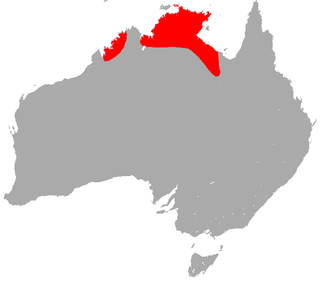
The long-tongued nectar bat, also known as the northern blossom bat, honey nectar bat, least blossom-bat, dagger-toothed long-nosed fruit bat, and lesser long-tongued fruit bat, is a species of megabat. M. minimus is one of the smallest species in the family Pteropodidae, with an average length of 60–85 mm. It has a reddish-brown colouring with relatively long hair compared to the other species. The hair on the abdomen is a lighter colour, and a dark brown stripe runs bilaterally down the top of the head and back.

The red-cheeked dunnart is so called because of the distinctive red hair on its cheek. It is an Australasian marsupial. Its total length is 167–270 mm (6.6–10.6 in); its average body length is 80–135 mm (3.1–5.3 in) with a tail of 87–135 mm (3.4–5.3 in). Ear length is 12–13 mm (0.47–0.51 in). Its weight varies between 18 and 75 g. Its tail is thin and pale pink.

Gould's long-eared bat is a microbat found in southern regions of Australia. It occurs in eastern Australia, from Queensland to Victoria, and in a smaller isolated range in the south-west of Western Australia.

The pale field rat is a small rat endemic to Australia. It is a nocturnal and herbivorous rodent that resides throughout the day in shallow burrows made in loose sand. Once widespread, its range has become greatly reduced and it is restricted to the grasslands, sedges, and cane-fields at the north and east of the continent. Its fur is an attractive yellow-brown colour, with grey or cream at the underside. This medium-sized rat has a tail shorter than its body.

The inland broad-nosed bat is a species of vesper bat. They are endemic to Australia and widespread throughout the inland, especially in arid and semi-arid regions. This insectivorous microbat, measuring 12 centimetres (4.7 in) in length, roosts in tree hollows during the day and forages over woodland and water at night.

Rüppell's or the greater broad-nosed bat is a species of vespertilionid microbat found in eastern Australia.
The eastern broad-nosed bat or Orion broad-nosed bat is a species of vespertilionid bat. It is found only in Australia, east of the Great Dividing Range, from about Rockhampton to Melbourne, with a small isolated population on the Atherton Tablelands.

The flute-nosed bat is a vespertilionid bat with an unusually shaped nose, the tubular nostrils facing outward from the end of the muzzle. They occur in the north of the Australian state of Queensland, in Indonesia, and on Papua New Guinea.
The inland forest bat is a vesper bat that occurs in central and arid regions in Australia. They were first described in 1987, published in a review of poorly surveyed microbat populations. A tiny flying mammal, it occupies small cavities in trees and buildings while roosting. The nocturnal activity is foraging for insects, typically moths.
The northern cave bat is a vesper bat that occurs throughout most of Australia.
The yellow-lipped cave bat is a vesper bat that only occurs in the Kimberley region of northwest Australia. The bat was first captured at Tunnel Creek in 1958 and a description published nearly twenty years later. Aside from observations of their physical characteristics, a preference for caves, and hunting insects over streams, little is known of the species.
Finlayson's cave bat is a species of vesper bat found only in Australia.

Xeromys myoides, also known as the water mouse, marine mouse, mangrove mouse, false water rat, manngay and yirrkoo, is a species of rodent native to waterways of Australia and Papua New Guinea.

The Papuan sheath-tailed bat is a species of bat in the family Emballonuridae which occurs at the Cape York Peninsula and New Guinea. The poorly known species hunts in open forests for night flying insects.

The rufous owl, also known as the rufous boobook, is a species of owl in the family Strigidae. It was described in 1846 by John Gould, an English ornithologist. Its common name reflects the rufous-coloured feathers that these owls are covered with in adulthood. While it is uncommon, the species has a wide range, including Australia, Indonesia, and Papua New Guinea.

The northern leaf-nosed bat is a micro-bat of the family Hipposideridae, known as "leaf-nosed" bats. The species is endemic to northern regions of Australia. They are highly manoeuvrable in flight, and use echolocation to forage for insect prey.

The smaller horseshoe bat is a species of bat in the family Rhinolophidae. It is found in Australia and Papua New Guinea.

Scotorepens is a genus of bats within the Vespertilionidae family. Species within this genus are widely distributed across Australia and to the north at Papua New Guinea and Indonesia.
Ozimops cobourgianus is a species of molossid bat, insectivorous flying mammals known as freetail bats, which are found in north and west coastal regions of Australia. First described in 1959, the group were later recognised as species Mormopterus cobourgianus and soon placed with a new genus. They are associated with mangrove habitat and roost in the hollows of those trees, and known to seek food there and in eucalypt or melaleuca woodland or other coastal habitat. A smaller bat of genus Ozimops, O. cobourgianus are around fifty millimetres long and weigh six to ten grams. Little is known of their habits.













